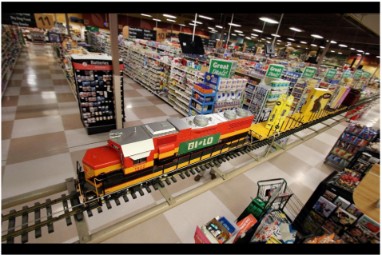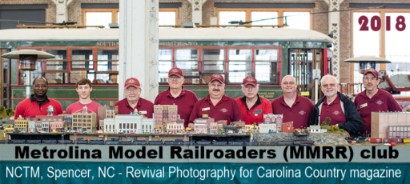In the past couple years, although the space that the Metrolina Model Railroaders have been allotted has dwindled, our enthusiasm and excitement for sharing the wonders of model railroading and the joyful splendors of the Christmas spirit has not. We keep coming up with fresh ideas to share with visitors and shoppers of the Southern Christmas Show for whom we really appreciate providing us with a venue during the holiday season to help us entertain and celebrate with those that come through each year.


Mrs. Karolyn Grimes
was Zuzu Bailey in 1946 It’s a Wonderful Life
This year, we were informed that a special guest, Mrs. Karolyn Grimes, a child actress in the move “It’s a Wonderful Life”, will be attending. Mrs. Grimes played Zuzu Bailey alongside Mr. James “Jimmy” Stewart as one of his daughters in this classic holiday movie where a man who has given up on his personal dreams to help others in his community considers ending his life until he is shown by a guardian angel all the lives he touched and what the world would be like if he had not existed. The movie has become one of the greatest films of all time and among the best Christmas films. To honor Mrs. Grimes, we have added a new diorama to an adapted corner module this year, that features an American Drive-In Movie Theater as it might have looked during the height of their popularity in 1955, and it will be playing It’s a Wonderful Life which entered the public domain in 1974.

On May 16, 1933, Richard Hollingshead Jr., an auto-parts store manager, patented the idea of the Drive-in theater. On June 6th, 1933, he and three other investors cut the ribbon on the world’s first Drive-in movie theater and opened it to the public in Camden, New Jersey. People paid 25 cents per car as well as per person to see the British Comedy Wives Beware. Drive-in theaters became very popular, and at the height of their popularity in the 1950’s and 1960’s, there were roughly 4,000 drive-in theaters across the United States.
Among its advantages was the fact that older adults with children could take care of their infants while watching a movie. At the same time, youth found drive-ins ideal for dates. Unlike indoor cinema theaters, there was an air of informality that was appealing to people of all ages, but specifically to families.



Although most Drive-in movie theaters were operated in the summer months, we felt like this would be a splendid opportunity to share a little bit of the World’s Greatest Hobby of Model Railroading with you. Come out and visit us during the Southern Christmas Show at The Park Expo & Conference Center, 800 Briar Creek Rd, Charlotte, NC 280205 (Off Independence Highway), in November 2024, the 14th thru the 24th. If you come during the second weekend, the 22nd thru the 24th, Mrs. Karolyn Grimes, Zuzu Bailey, from “It’s a Wonderful Life” will be selling her cookbook, which includes delicious recipes, movie anecdotes, interviews, trivia, photos and more. She will also have other movie memorabilia and gifts for sale. Come see Zuzu while doing lots of Christmas shopping and don’t forget to stop by the model train display booth #31B in Olde Towne near Santa Claus and take a gander at our tribute to Mrs. Grimes which can be found on one of the rear, corner modules featuring our New 1955 Drive-in Movie Theater.
As the author of this article and the main developing model architect of the Metrolina Model Railroader’s New Christmas Edition 1955 Drive-in Movie Theater, who happens to live in Belmont, North Carolina, you may be excited to know that there is an operating Drive-In movie theater located at 314 McAdenville Road, Belmont, North Carolina 28012 and they are playing movies every Friday and Saturday night through December 7th this 2024 Holiday Season. If you wish to experience the enjoyment of a real drive-in movie theater, check out their schedule on Facebook at: https://www.facebook.com/p/Belmont-Drive-In-100063570731472/ or their website at: https://belmontdriveinmovies.com/. Celebrate with them on December 6th, 2024, and join in the fun by wearing an Ugly Christmas Sweater during the night of their final weekend of this season.
October 27th, 2024 Henry, MMRR Webmaster. Updated & Published November 17th, 2024.



Press Release. You can download this press release file about the Metrolina Model Railroader’s 2024 Southern Christmas Show New 1955 Drive-In Movide Theater Diorama module.
File Name: About-the-MMRR-Drive-in-Christmas-Module-2024-11-17_OfficialCopy.pdf




































